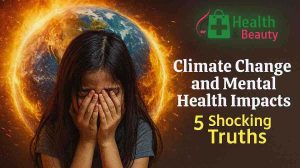The sun beat down like an ancient storyteller, relentless and unyielding, as Malik labored through another sweltering afternoon in his rice paddy on the outskirts of Jakarta. The air shimmered with heat, making his vision waver, and even the cicadas seemed subdued in resignation. He paused, wiping sweat from his brow, breathing in smoke from nearby wildfires drifting across the horizon, and wondered: “Is this what it means to live in a world altered by climate?”
In that moment, the question becomes urgent, deeply personal, and undeniably human: How Does Climate Change Affect Human Health? It’s not a distant headline—it’s Malik’s dizziness, a child’s wheezing lungs, an elderly neighbor’s missed heartbeat during a heatwave. This is lived reality, sculpted by rising temperatures, shifting diseases, and silent threats that ripple through communities unseen.
How Does Climate Change Affect Human Health
1. Dire Projections: The Scale of Human Impact
Global health organizations estimate 250,000 additional deaths per year between 2030 and 2050 from malnutrition, malaria, diarrhea, and heat stress.
Economic analyses project that by 2050, climate change could cause 14.5 million more deaths globally and inflict trillions in economic losses.
By 2030, health-related damages could push at least 44 million people into extreme poverty.
These staggering figures underscore why understanding How Does Climate Change Affect Human Health matters deeply—it is shaping the survival and well-being of billions.
For a deeper understanding of the relationship between climate and human health, the World Health Organization provides a comprehensive report highlighting the global impact of rising temperatures on disease patterns, nutrition, and premature deaths.
2. Heatwaves: Accelerated Aging and Premature Mortality
Research shows that exposure to frequent heat waves accelerates biological aging by days or even weeks—effects comparable to smoking or heavy alcohol use.
Heat-related deaths among elderly populations have risen dramatically, with some regions recording over 150% increases since the 1990s.
Takeaway: Heatwaves are not just uncomfortable—they’re shortening lives at the cellular level, pushing health risks forward by years.
Actionable Tip: Advocate for community cooling centers, heat-alert systems, and tree-shade corridors—mitigation rooted in social infrastructure.
3. Air Pollution: A Hidden Killer
Every year, millions die prematurely from illnesses linked to polluted air, with cardiovascular and respiratory diseases leading the way.
Transitioning to clean energy sources could save thousands of lives annually while creating economic benefits worth billions in healthcare savings.
Insight: Breathing becomes a battleground—pollutants magnify cardiovascular and respiratory risks, compounding climate’s health burdens.
Tips: Promote renewable energy, support congestion initiatives, and choose clean-air indoor ventilation to reduce exposure.
For readers curious about how indoor air quality can compound the risks of smog and heat, this article on How Air Quality Affects Health: Hidden Indoor Pollutants That Could Harm You sheds light on unseen dangers lurking inside homes, discussing allergens, volatile organic compounds, and practical tips to safeguard your breathing space.
4. Infectious Diseases: Expanding Frontiers
Over half of known infectious diseases have been aggravated by climatic hazards.
Warmer coastlines now support bacteria and viruses once confined to tropical zones, expanding the range of illnesses like cholera and dengue fever.
Example: Dengue outbreaks have surged dramatically in recent years as heatwaves and heavy rains create perfect breeding grounds for mosquitoes.
Tips: Strengthen disease surveillance, clean water access, and vector control, particularly in heat-affected regions or post-flooding zones.
5. Mental Health: Climate-Driven Stress and Trauma
Climate-related disasters and extreme heatwaves increase risks of anxiety, depression, PTSD, and even suicidal behavior.
Long-term studies reveal that even small rises in average temperatures can worsen mental health disorders at population levels.
Perspective: The psychological toll isn’t abstract—it’s trauma, grief, the loss of place and identity (solastalgia), especially among the marginalized.
Advice: Prioritize community mental health support, climate-aware counseling, and psychosocial resilience programs.
To understand how technology is transforming mental health support in the face of climate-related stress, check out Artificial Intelligence in Healthcare: 9 Incredible Benefits which highlights real-world applications like early warning systems and personalized care—offering a hopeful outlook on future adaptation.
6. Emerging Risks: Sleep Apnea and Wildfires
Warmer nights correlate with a higher prevalence of sleep apnea, disrupting rest and productivity while raising healthcare costs.
Lightning-sparked wildfires are increasing in frequency, threatening lives and worsening respiratory health risks due to massive smoke exposure.
Implication: Climate change sneaks into our nights and disrupts our recovery—health isn’t just daytime exposure.
Steps: Insist on disaster-prepared infrastructure, enforce fire-safe zoning, and advocate for emergent healthcare support systems.
7. Inequity: Who Pays the Greatest Price?
Vulnerable populations—those in poverty, the elderly, people with disabilities—face disproportionate health burdens from climate impacts.
Projections show billions of workers will be exposed to dangerous heat levels, jeopardizing livelihoods and safety.
Reality Check: Climate health risks are magnified by social inequities—making adaptation and justice inseparable.
Actionable Focus: Equip employers, policymakers, and community leaders with equitable adaptation plans, occupational protections, and inclusive services.
Final Thoughts: Why This Matters to You
Understanding How Does Climate Change Affect Human Health is not academic—it’s every morning’s inhale and every evening’s retraced steps. It’s the aging cell, the infected child, the sleepless nights. But confronting that reality enables meaningful action.
- Actionable outreach: Engage in local climate-health education and policy advocacy.
- Personal practices: Prioritize cleaner energy, greener living, and supportive community behaviors.
- Support for the vulnerable: Champion healthcare access, cooling solutions, and mental health services for those most at risk.







